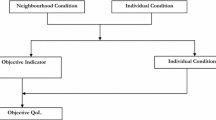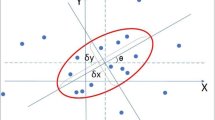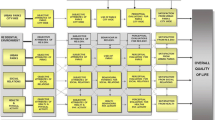Abstract
The study explores whether Quality of Life (QOL) corresponds to the spatial pattern of urban system as a result of compact development policy practice in Bandung city, Indonesia. It examines the connection between QOL and selected attributes of compact development. A self-reported life satisfaction is used as a proxy for QOL based on a cross-sectional survey data from 400 respondents. The analysis shows that the changes in QOL significantly correspond to the change of different attributes of compact development. The result suggests that compact development policies in Bandung have not shown a desirable result in improving QOL of the urban residents. The result also indicates that the implementation of the policy is less beneficial in the context of developing countries. The study strengthens the existing argument that compact development policies need to be tailored to suit the context of developing countries, rather than just be taken for granted from the practices in developed countries.


Similar content being viewed by others
References
Bandung CSA. (2008). Bandung in figures 2008. Bandung: Central Statistic Agency of Bandung City.
Bandung PDA. (2003). Bandung city master plan 2003–2013. Bandung: Planning and Development Agency of Bandung City.
Bramley, G., & Power, S. (2009). Urban form and social sustainability: the role of density and housing. Environment and Planning B: Planning and Design, 36, 30–48.
Bruegmann, R. (2005). Sprawl: A compact history. Chicago: University of Chicago Press.
Burgess, R. (2000). The compact city debate: A global perspective. In M. Jenks & R. Burgess (Eds.), Compact cities: Sustainable urban forms for developing countries (pp. 9–24). London: Spon.
Burton, E. (2000). The compact city: just or just compact? A preliminary analysis. Urban Studies, 37(11), 1969–2006.
Caruthers, J. I., & Ulfarsson, G. F. (2008). Does smart growth matter to public finance? Urban Studies, 45(9), 1791–1823.
Clark, A. E., & Oswald, A. J. (1994). Unhappiness and unemployment. Economic Journal, 104, 648–659.
Clark, A. E., & Oswald, A. J. (1996). Satisfaction and comparison income. Journal of Public Economics, 61(3), 359–381.
Costanza, R., Fisher, B., Ali, S., Beer, C., Bond, L., Boumans, R., et al. (2007). Quality of life: an approach integrating opportunities, human needs, and subjective well-being. Ecological Economics, 61, 267–276.
Cummins, R. A., Eckersley, R., Pallant, J., van Vugt, J., & Misajon, R. (2003). Developing a national index of subjective wellbeing: the Australian unity wellbeing index. Social Indicators Research, 64(2), 159–190.
Cummins, R. A., Walter, W., & Woerner, J. (2007). Australian unity well-being index: Report 16.1—The well-being of Australians—Groups with the highest and lowest well-being in Australia. Melbourne: Australian Centre on Quality of Life, School of Psychology, Deakin University.
Cutler, D., & Glaeser, E. L. (1997). Are ghettos good or bad? Quarterly Journal of Economics, 112, 827–872.
Dawkins, C. J., & Nelson, A. C. (2003). State growth management programs and central city revitalization. Journal of the American Planning Association, 72(1), 19–31.
Day, R. (2007). Place and the experience of air quality. Health and Place, 13, 249–260.
De La Cruz, E. E. R. (2009). Local political institutions and smart growth: An empirical study of the politics of compact development. Urban Affairs Review, 45(2), 218–246.
Dijst, M. V. (2000). Compact urban policies in Randstand Holland. In G. D. Roo & D. Miller (Eds.), Compact cities and sustainable development: A critical assessment of policies and plans from an international perspective. Hampshire: Ashgate.
Dissart, J. C., & Deller, S. C. (2000). Quality of life in the planning literature. Journal of Planning Literature, 15, 135–159.
Di Tella, R., & MacCulloch, R. J. (2006). Some uses of happiness data in economics. Journal of Economic Perspectives, 20(1), 25–46.
Di Tella, R., MacCulloch, R. J., & Oswald, A. J. (2001). Preferences over inflation and unemployment: evidence from surveys of happiness. American Economic Review, 91, 335–341.
Dujardin, C., Selod, H., & Thomas, I. (2008). Residential segregation and unemployment: the case of Brussels. Urban Studies, 45(1), 89–113.
Easterlin, R. E. (1995). Will raising the income of all increase the happiness of all? Journal of Economic Behaviour and Organization, 27, 342–353.
Easterlin, R. A. (2001). Income and happiness: towards a unified theory. Economic Journal, 111, 465–484.
Ewing, R., & Rong, F. (2008). The impact of urban form on U.S. residential energy use. Housing Policy Debate, 19(1), 1–30.
Ferrer-i-carbonell, A., & Fritjers, P. (2004). How important is methodology for the estimates of the determinants of happiness? Ecological Economics, 60(3), 509–516.
Frey, H. (1999). Designing the city: Towards a more sustainable urban form. London: E. & F. N. Spon.
Frey, B. S., & Stutzer, A. (2002). What can economists learn from happiness research? Journal of Economic Literature, 40, 402–435.
Frey, B., & Stutzer, A. (2005a). Happiness research: state and prospects. Review of Social Economy, 62(2), 207–228.
Frey, B. S., & Stutzer, A. (2005b). Stress that doesn’t pay: the commuting paradox. Review of Social Economy, 62(2), 207–228.
Frey, B. S., Luechinger, S., & Stutzer, A. (2009). The life satisfaction approach to valuing public goods: the case of terrorism. Public Choice, 138, 317–345.
Fritjers, P., Haisken-DeNew, J. P., & Shields, M. A. (2004). Money does matter! Evidence from increasing real incomes and life satisfaction in East Germany following reunification. American Economic Review, 94, 730–740.
Haughton, G., & Hunter, C. (1994). Sustainable Cities. London: Jessica Kingsley.
Landis, J. D. (2006). Growth management revisited. Journal of the American Planning Association, 72(4), 411–430.
Layard, R. (2006). Happiness and public policy: a challenge to the orofession. Economic Journal, 116(510), C24–C33.
MacKerron, G., & Mourato, S. (2009). Life satisfaction and air quality in London. Ecological Economics, 68(5), 1441–1453.
Massam, B. H. (2002). Quality of life: public planning and private living. Progress in Planning, 58, 141–227.
McMahon, D. M. (2006). Happiness: A history. New York: Atlantic Monthly.
Meijers, E. (2008). Summing small cities does not make a large City: Polycentric urban regions and the provision of cultural, leisure and sport amenities. Urban Studies, 45(11), 2323–2342.
Moro, M., Brereton, F., Ferreira, S. J., & Clinch, P. (2008). Ranaking quality of life using subjective well-being data. Ecological Economics, 65, 448–460.
Moulton, B. R. (1990). An illustration of a pitfall in estimating the effects of aggregate variables on micro units. Review of Economics and Statistics, 72(2), 334–338.
Mulder, K., Constanza, R., & Erickson, J. (2006). The contribution of built, human, social and natural capital to quality of life in intentional and unintentional communities. Ecological Economics, 59, 13–23.
Neuman, M. (2005). The compact city fallacy. Journal of Planning Education and Research, 25(11), 11–26.
Neuman, M. (2009). The compact city fallacy. Journal of Planning Education and Research, 25(1), 1–26.
Newman, P., & Kenworthy, J. (1999). Sustainability and cities: Overcoming automobile dependence. Washington D.C.: Island.
Pacione, M. (2003). Urban environmental quality and human wellbeing—a social geographical perspective. Landscape and Urban Planning, 65(1–2), 19–30.
Pendall, R. (1999). Do land use controls cause sprawl? Environment and Planning B, 26, 555–571.
Petersen, R. (2002). Land use planning and urban transport. A sourcebook for policy-makers in developing cities. Eshborn: GTZ.
Powdthavee, N. (2008). Putting a price tag on friends, relatives, and neighbours: using surveys of life satisfaction to value social relationships. The Journal of Socio-Economics, 37(4), 1459–1480.
Redfearn, C. L. (2009). Persistence in urban form: the long-run durability of employment centers in metropolitan areas. Regional Science and Urban Economics, 39(2), 224–232.
Rehdanz, K., & Maddison, D. (2008). Local environmental quality and life-satisfaction in Germany. Ecological Economics, 64, 787–797.
Robin, M., Matheau-Policea, A., & Couty, C. (2007). Development of a scale of perceived environmental annoyances in urban settings. Journal of Environmental Psychology, 27(1), 55–68.
Sandercock, L. (1997). Towards cosmopolis: Planning for multicultural cities. London: Wiley.
Sandercock, L. (2000). Cities of (in) difference and the challenge for planning. DISP, 140, 7–15.
Selod, H., & Zenou, Y. (2006). City structure, job search, and labor discrimination: theory and policy implications. Economic Journal, 116, 1057–1087.
Shen, Q., & Zhang, F. (2007). Land use changes in a pro smart growth state: Maryland, USA. Environment and Planning A, 39(6), 1457–1477.
Ulengin, B., Ulengin, F., & Guvenc, U. (2001). A multidimensional approach to urban quality of life: the case of Istambul. European Journal of Operational Research, 130, 361–374.
Van Praag, B. M. S., & Baarsma, B. E. (2005). Using happiness surveys to value intangibles: the case of airport noise. The Economic Journal, 115(500), 224–246.
Veenhoven, R. (2006). Quality of life in modern society. In Y.-K. Ng & L. S. Ho (Eds.), Happiness and public policy, theory, case studies and implications (pp. 19–44). New York: Macmillan.
Vemuri, A. W., & Costanza, R. (2006). The role of human, social, built, and natural capital in explaining life satisfaction at the country level: toward a national well-being index (NWI). Ecological Economics, 58(1), 119–133.
Welsch, H. (2006). Environment and happiness: valuation of air pollution using life satisfaction data. Ecological Economics, 58(4), 801–813.
Williams, K. (2000). Does intensifying cities make them more sustainable? In K. Williams et al. (Eds.), Achieving sustainable urban form: An introduction (pp. 30–45). New York: E & FN Spon.
Wilson, W. J. (1987). The truly disadvantaged: The inner city, the underclass and public policy. Chicago: The University of Chicago Press.
Yeh, A. G. (2008). GIS as a planning support system for planning of harmonious cities. Nairobi: Un-Habitat.
Yusuf, A. A., & Resosudarmo, B. P. (2009). Does clean air matter in developing countries’ megacities? A hedonic price analysis of the Jakarta housing market, Indonesia. Ecological Economics, 68(5), 1398–1407.
Acknowledgements
This paper benefits greatly from the insightful comments by two anonymous referees.
Author information
Authors and Affiliations
Corresponding author
Rights and permissions
About this article
Cite this article
Arifwidodo, S.D., Perera, R. Quality of Life and Compact Development Policies in Bandung, Indonesia. Applied Research Quality Life 6, 159–179 (2011). https://doi.org/10.1007/s11482-010-9123-5
Received:
Accepted:
Published:
Issue Date:
DOI: https://doi.org/10.1007/s11482-010-9123-5




